Physical Address
304 North Cardinal St.
Dorchester Center, MA 02124
Grossly the lungs are subdivided into lobes, three on the right (upper, middle, and lower) and two on the left (upper and lower). Each lobe is supplied by a dedicated lobar bronchus with a companion artery and vein that subdivides into bronchopulmonary segments. Bronchopulmonary segments are of special importance to thoracic surgeons because they are amenable to surgical excision in those patients for whom less than lobectomy is preferred. The cut surface of normal lung is characterized by connective tissue septa that subdivide the parenchyma into polygonal pulmonary lobules ( Fig. 10.1 ).
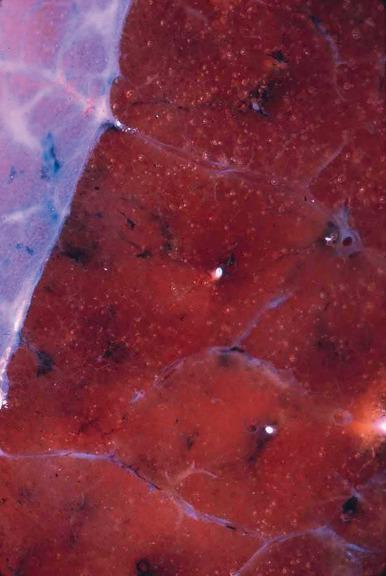
The two main components of the lung interstitium are the alveolar walls and the extra-alveolar connective tissue affiliated with bronchopulmonary bundles, interlobular septa, and visceral pleura. The alveoli are normally covered primarily by type I pneumocytes with small attenuated nuclei and large cytoplasmic processes and cuboidal type II (granular) pneumocytes with a hobnail appearance; the latter produce surfactant and comprise the minority of alveolar lining cells in normal lungs but are the main proliferating component after alveolar injury. The alveolar walls contain capillaries whose basement membrane fuses with that of the alveolar epithelium to constitute a single alveolar capillary membrane.
The main types of bronchial and bronchiolar epithelial cells are basal cells, neuroendocrine cells, ciliated cells, serous cells, Clara cells, and goblet cells. Goblet and ciliated cells decrease in number as one approaches the terminal bronchioles, whereas the number of Clara cells increases proportionally. Clara cells have a secretory function and represent the main progenitor cells after bronchiolar injury. They are recognized—whether in normal, reactive, or neoplastic conditions—by the presence of apical secretory granules that are periodic acid–Schiff (PAS) positive and diastase resistant and have a dense appearance ultrastructurally. Airway-associated neuroendocrine cells are part of the diffuse neuroendocrine system and are numerous in the fetus and neonate but very scanty and difficult to demonstrate in the adult.
Small clusters of neuroendocrine cells located within the epithelium of bronchi and bronchioles (and sometimes also at the level of alveoli) are referred to as neuroepithelial bodies ; their function is unknown.
Submucosal glands are associated with the larger bronchi; they are composed of both serous and mucous cells and are invested by a myoepithelial cell layer. In older individuals, these glands may exhibit oncocytic changes.
Structures sometimes seen in alveolar spaces that are of no diagnostic significance include fresh red blood cells (usually the result of surgical trauma), alveolar macrophages that are frequently pigmented in smokers, corpora amylacea (common in elderly people), and blue bodies (composed primarily of calcium carbonate). The lungs of adult city dwellers often contain black anthracotic pigment (carbon); scattered birefringent silica crystals may also be found, a feature which, by itself, is not diagnostic of silicosis.
Megakaryocytes are a common incidental finding in the alveolar walls; the large, hyperchromatic, and distorted nuclei of these cells should not be misinterpreted as evidence of malignancy or viral infection.
Metaplastic bone is an age-related change sometimes seen in the bronchial cartilage; it may be accompanied by calcification and by bone marrow elements.
Lymph vessels follow the bronchovascular structures and are found mainly beneath the pleura and in septa, but not in alveolar walls. They drain to intrapulmonary peribronchial and hilar lymph nodes. The drainage is mainly cephalad, primarily through mediastinal lymph node groups, but also to abdominal lymph nodes.
Intrapulmonary lymph nodes may be found in the peribronchial region and occasionally as individual intraparenchymal nodules in the peripheral, subpleural lung. The vasculature of the lung derives from the pulmonary vessels and bronchial vessels, the latter belonging to the systemic circulation. Pulmonary arteries have both an internal and external elastic membrane, whereas pulmonary veins have a single (outer) elastic layer.
Ectopic tissues sometimes occur in otherwise normal lung or form localized abnormalities and comprise skeletal muscle (sometimes present extensively in the newborn lung, a condition known as rhabdomyomatosis ), neuroglial elements, pancreas, and adrenal cortex. Histologically normal thyroid tissue occurs only rarely in the lung; whether all such cases represent metastases from well-differentiated carcinomas remains controversial.
Lung biopsies performed to evaluate patients suspected of having non-neoplastic lung diseases come in many different shapes and sizes. Small closed biopsies are often done to minimize procedural risk and morbidity. The relative value of different procedures depends on the clinical and radiological setting. It is helpful, especially when interpreting smaller specimens, for the pathologist to know the clinical history and radiological findings before drawing a firm conclusion regarding the diagnosis. Basic facts such as patient age, whether or not the patient is immunocompromised, onset and tempo of disease progression (i.e. acute or chronic), localized versus diffuse radiological distribution of abnormalities, presence and degree of functional impairment, and occupational or travel history can be especially helpful in this regard.
The type of lung biopsy obtained is also important. Wedge biopsies have the highest sensitivity, specificity, and accuracy for nearly all non-neoplastic lung diseases, but smaller biopsies obtained through a bronchoscope using either a biopsy forceps ( transbronchial biopsy) or a cryoprobe (cryobiopsy) are especially helpful in certain diseases like infections, sarcoidosis, diffuse alveolar damage (DAD), pulmonary alveolar proteinosis, eosinophilic pneumonia, and hypersensitivity pneumonia. Histologic findings that complicate interpretation of transbronchial biopsies include a ‘holes’ or ‘bubbles’ artifact that mimics the appearance of exogenous lipid pneumonia, procedure-related hemorrhage which is common, and mesothelial cells when the biopsy unintentionally captures pleural tissue. Multiple-step sections are extremely helpful in maximizing the diagnostic yield of transbronchial lung biopsies, especially in patients suspected of having sarcoidosis.
Surgical lung biopsies are especially useful in patients suspected of having idiopathic interstitial pneumonias, such as usual or nonspecific interstitial pneumonia (NSIP). The lingula and right middle lobes may be appropriate biopsy targets depending on the radiological distribution of abnormalities. Areas of extreme scarring and honeycombing are likely to show only end-stage disease and therefore are not very informative. Ideally, samples should be obtained from two or three different areas. A formalin-filled syringe attached to a small (25-gauge) needle may be used to gently infuse fixative into wedge biopsies until fully expanded. A simpler approach is to remove the staple line before teasing apart the lung parenchyma and using a fresh scalpel blade to breadloaf the sample from the nonpleural surface. Routine submission of tissue for microbiologic studies has little value and is a procedure best reserved for patients in whom the clinical suspicion of infection is high.
Cystic lung diseases may be congenital or acquired, and each of these categories can be further subdivided into localized and diffuse diseases. Some of the diffuse diseases in which cysts are a prominent radiological finding (e.g. lymphangioleiomyomatosis, Langerhans cell histiocytosis [LCH]) are reviewed elsewhere.
Congenital cystic disease is a generic term for any cystic process of the lung thought to be already present at birth. Congenital cystic diseases are generally viewed as diseases of childhood, but they occasionally go undetected until adulthood. The most common types of congenital cystic disease encountered in surgical pathology include congenital lobar overinflation (i.e. congenital lobar emphysema ), congenital cystic adenomatoid malformation (CCAM) also referred to as congenital pulmonary airway malformation (CPAM), bronchogenic cyst, and pulmonary sequestration. A significant overlap exists between these entities, suggesting a common pathogenesis. Some patients also have extrapulmonary anomalies. Congenital cystic diseases of the lung are frequently diagnosed in utero and are associated with excellent postnatal outcomes in the absence of fetal hydrops or other severe congenital abnormalities.
Congenital lobar overinflation (congenital lobar emphysema) occurs in young children. It affects only one of the upper lobes or the right middle lobe of the lung. Theories for its occurrence include mucosal folds, mucous plugs, and deficiencies in the bronchial cartilages. The pathologic change consists of massive overdistention of the alveolar spaces, not accompanied by tissue destruction. It is therefore not truly a cystic or an emphysematous process. Severe compression of the other pulmonary lobes may result from this lesion.
CCAM (CPAM) is characterized by the presence of variously sized intercommunicating cysts lined by cuboidal-to-ciliated pseudostratified columnar (‘adenomatoid’) epithelium ( Figs. 10.2 to 10.4 ). Those that are not detected prenatally usually present with respiratory distress in early infancy due to compression of lung tissue and mediastinal shift. They are usually solitary and involve a single lobe. Some go undetected until later in life when they may be complicated by mucinous adenocarcinoma with lepidic-predominant (bronchioloalveolar) growth patterns. Three morphologic variants have been described based on size and number of cysts (Stocker types 1, 2, and 3). These subcategories show significant histologic overlap limiting their value. They can be more simply divided into large (>2 cm) and small (<2 cm) cyst types, roughly corresponding to Stocker types 1 and 2, respectively. Large cyst CCAMs can be unilocular or multilocular and show cystic spaces lined by ciliated respiratory epithelium. Mucinous columnar epithelium resembling gastric mucosa may be present in both the cyst wall lining and adjacent lung tissue. Small cyst CCAMs show a compact arrangement of irregularly shaped microcystic spaces and variable numbers of tubular bronchiole-like structures that lack companion arteries. Mucinous epithelium is less common than in large cystic variants.
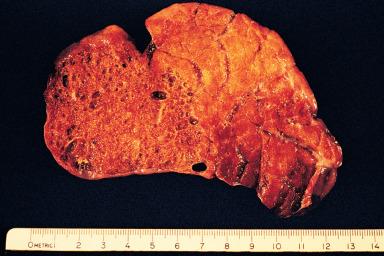
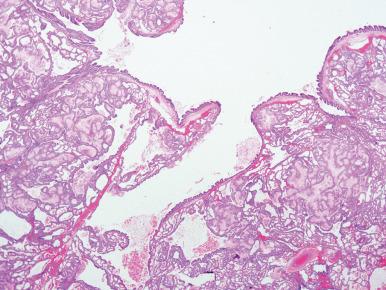
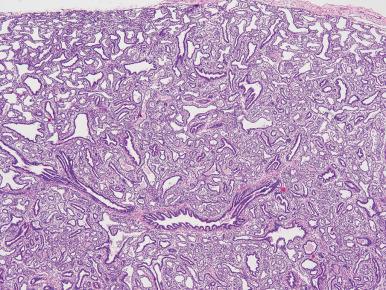
Acquired cystic diseases of the lung are a heterogeneous group of unrelated lesions that have in common the presence of cysts on computed tomography (CT) scans of the chest. Emphysema is the most common form of acquired cystic disease and is defined as an increase in the size of airspaces distal to the terminal bronchiole associated with destruction of their walls. Emphysema is the most important morphologic substrate of chronic obstructive pulmonary disease, which in turn is a leading case of disability and death. Emphysema is most commonly encountered as an incidental finding in surgical specimens excised for other reasons, in wedge resections following pneumothorax, as part of volume reduction surgery in patients with severe disease, or in explanted lungs from patients undergoing transplantation. Emphysematous bullae are large (1 cm or greater) cystic spaces covered by a thin, stretched pleura. Giant bullae can result in an appearance vaguely reminiscent of chorionic villi, a change that has been designated as placental transmogrification ( Fig. 10.5 ). Symptoms may result from hemorrhage, infection, compression of adjacent lung, or pneumothorax. Blebs are formed by the rupture of an alveolus directly beneath the pleura and the escape of air into the areolar layer of the pleura, which results in interstitial emphysema. They are less than 1 cm in diameter. A bleb may rupture into the free pleural space, causing pneumothorax and reactive eosinophilic pleuritic , which is a common finding after pneumothorax of any cause.
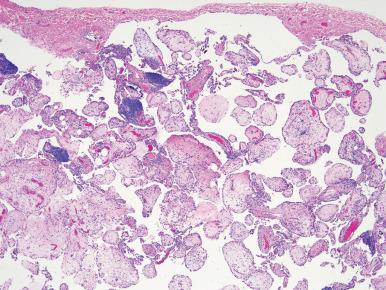
Swyer–James (McLeod) syndrome , thought to be the result of repeated episodes of pulmonary infection, is characterized by the development of severe emphysema (occasionally accompanied by placental transmogrification), bronchiectasis, and/or bronchiolitis obliterans.
Pleuropulmonary blebs and cysts (usually basilar) can represent the pulmonary component of the Birt–Hogg–Dubé syndrome , a rare genodermatosis associated with an increased risk of renal and colonic neoplasia.
Chondroid cystic malformation associated with trisomy 8 mosaicism is a rare form of localized cystic lung malformation in which connective tissue septa contain cartilaginous islands.
Bronchopulmonary sequestration is characterized by partial or complete separation of a portion of a lobe of the lung with a systemic arterial supply often affiliated with no connection to the functional components of the tracheobronchial tree (bronchial atresia) . The pathogenesis of sequestration remains controversial, but most authorities argue persuasively that they are developmental abnormalities rather than acquired lesions.
The extralobar variety develops from aberrantly located pulmonary mesenchyme as an extrapulmonary island of lung tissue enveloped by its own pleural covering. Extralobar sequestrations can be located at any level from the thoracic inlet to the diaphragm, or even within the abdominal cavity ( Fig. 10.6 ). About 90% of cases occur in the left side. Other congenital malformations, especially diaphragmatic hernias, occur in approximately 20% of patients. On occasion, the sequestered lung communicates with the foregut. An association with polyhydramnios and edema has been observed. The arterial supply is usually by one or several small arteries from the aorta or one of its branches. The venous drainage is into the azygos system.
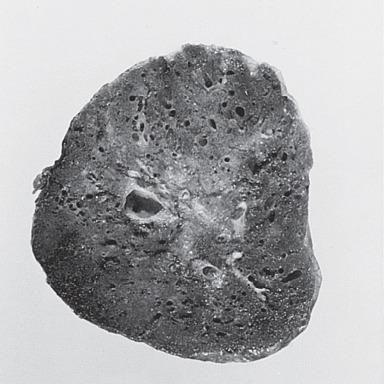
The intralobar variety is a more heterogeneous group for which the alternative term bronchial atresia with systemic vascular connection has been proposed. Intralobar sequestrations are much more likely to be symptomatic. They are characteristically located within the lower lobe, especially in the posterior basal segment, and are also more commonly located in the left lung ( Fig. 10.7 ). Grossly, the sequestered portion may present as a single cyst, as a multicystic area, or as a solid mass. The segment is supplied by a large artery arising from the aorta or one of its branches; this artery arises above the diaphragm in 75% of the patients and below the diaphragm in the remainder. Despite its origin, the artery is always of the elastic pulmonary type. Microscopically the findings are relatively nonspecific, reflecting the consequences of proximal bronchial atresia and comprise a combination of chronic inflammation and fibrosis. Key to diagnosis is the surgeon's identification of a large elastic artery representing the systemic vascular connection.
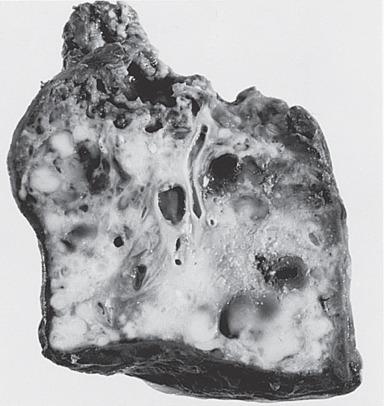
Bronchiectasis refers to the permanent dilation of bronchi usually associated with destruction of some elements of the bronchial wall and inflammatory changes that extend into the surrounding or distal lung parenchyma. It represents the end stage of a variety of unrelated disorders and can be divided into localized and diffuse forms.
Localized bronchiectasis often results from partial or total obliteration of the bronchial lumen by a neoplasm, foreign body, localized inflammatory process, inspissated mucus, or external compression (e.g. broncholithiasis due to a calcified lymph node) ( Fig. 10.8 ). It can occur in any area of the lung and follows the branching pattern of the obstructed bronchus. If the source of obstruction is relieved at an early stage, the bronchiectatic changes will regress; otherwise, the secondary inflammatory and fibrotic changes will render the condition irreversible. Localized bronchiectasis is a common finding in patients with middle lobe syndrome, a condition characterized by fixed radiological abnormalities limited to the right middle lobe and/or lingula.
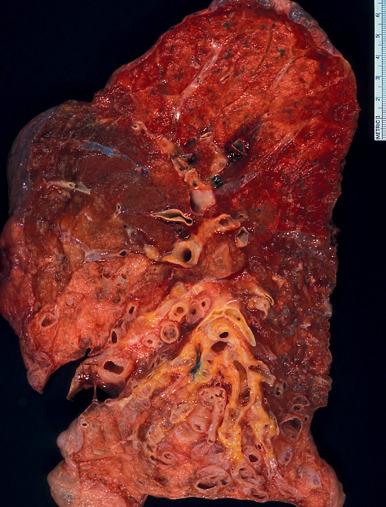
Diffuse bronchiectasis is a consequence of inflammation and postinflammatory destruction of airway walls that is usually the result of repeated episodes of infection. This is the form of bronchiectasis often seen in patients with cystic fibrosis ( Fig. 10.9 ). Two other disorders associated with chronic sinonasal infection and frequent bronchiectasis are Kartagener or immotile cilia syndrome (primary ciliary dyskinesia) , associated with complete situs inversus and infertility, and Young syndrome , associated with infertility caused by azoospermia but lacking ultrastructural ciliary abnormalities. The distribution of diffuse bronchiectasis depends on the underlying condition. For example, bronchiectasis patients with cystic fibrosis and allergic bronchopulmonary aspergillosis usually presents with upper lobe predominant disease.
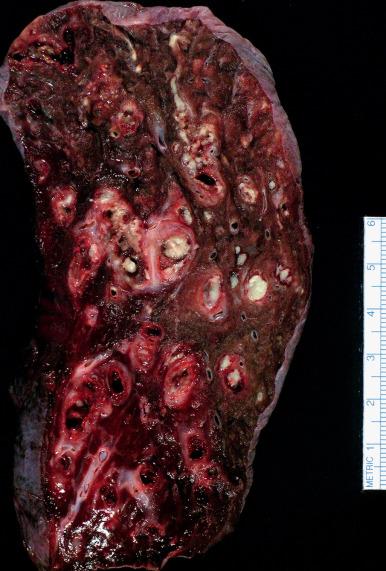
Inflammation of the bronchial wall is a constant finding in bronchiectasis of any cause and usually includes a mixed infiltrate of both acute and chronic inflammatory cells. Lymphocytes often predominate and typically include lymphoid aggregates with secondary germinal centers (i.e. lymphoid hyperplasia). Areas of ulceration are common, but the residual epithelium is usually ciliated and otherwise normal; squamous metaplasia can occur, but it is unusual. In a more advanced stage, granulation tissue develops in the lamina propria, the cartilage is fragmented or destroyed, and the muscle is erased or undergoes focal hyperplastic changes. The mucous glands persist longer than other structures. The bronchial arteries often become greatly enlarged, tortuous, and thick walled. Distal lung parenchyma, including smaller airways, usually shows a range of nonspecific postobstructive changes that may include organizing pneumonia. Multiple carcinoid tumorlets may occur in distal lung parenchyma and should not be confused with metastatic disease.
Complications of bronchiectasis such as bronchopleural fistula with empyema, brain abscess, and amyloidosis are no longer frequent. Conservative medical treatment focused on prevention or suppression of infection and early treatment for acute exacerbations is sufficient to control the disease in most patients. Surgical resection is limited primarily to patients with localized disease in whom hemorrhage and/or repeated pulmonary infections cannot be controlled with more conservative measures. Cystic fibrosis with respiratory failure is also an indication for double-lung transplants in highly selected patients.
In the pre-antibiotic era, solitary lung abscesses often followed tonsillectomies and other ear, nose, and throat operations. Presently, most lung abscesses follow the aspiration of foreign material or are a complication of necrotizing pneumonia ( Fig. 10.10 ).

The most common locations of lung abscesses in surgical series are the right lower lobe, the right upper lobe (particularly the subapical segment), and the left lower lobe, in that order of frequency ( Fig. 10.11 ). The apical segment of the lower lobes is particularly vulnerable in patients who must assume a supine position. Anaerobic organisms are the agents that are most commonly responsible. Chronic abscesses have thick fibrotic walls and are surrounded by areas of organizing pneumonia.
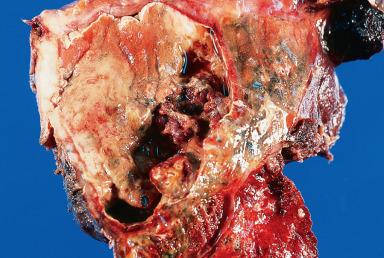
Lung abscesses in children are most commonly due to Streptococcus species, Staphylococcus aureus , and Klebsiella pneumoniae .
Complications of untreated lung abscesses include overgrowth of fungi (particularly Mucor and Aspergillus ) in the cavity, spread of the process to other portions of the lung, massive hemorrhage, bronchopleural fistula with empyema, and brain abscess.
Intravenous antibiotics have been used successfully for the treatment of lung abscesses, particularly in children. For small unilocular abscesses, aspiration and drainage or partial resection of the lobe may be curative. For larger lesions, lobectomy is preferable because it is associated with a much lower probability of postoperative complications such as bronchopleural fistula and empyema.
A large number of diseases in which granulomatous inflammation is a dominant feature involve the lung; some of them simulate radiological and gross features of neoplastic processes. Microscopic examination is insufficient to establish a specific diagnosis in some patients; therefore it is important to submit a sample for culture and to perform stains for mycobacteria (Ziehl–Neelsen) and fungi (Gomori methenamine silver, GMS) in every case.
Tuberculosis is second only to HIV as a cause for fatal infection in the developing world and remains a major global public health challenge. The prevalence of tuberculosis in the United States has fallen dramatically since the early 1990s and is now more commonly diagnosed in foreign-born rather than native-born persons. Tuberculosis in foreign-born persons is most commonly the result of reactivation of infection with multidrug-resistant organisms acquired before entry into the United States; secondary transmission accounts for fewer newly diagnosed cases. Most patients are diagnosed using a combination of skin testing, cultures, and other emerging techniques applied to sputum or blood.
Specimens harboring tuberculosis that are received in the pathology laboratory are usually from patients in whom some other diagnosis was suspected and may be a biopsy obtained with the fiberoptic bronchoscope, material procured via fine-needle aspiration, a surgical lung biopsy, or a resected lobe. There are still patients with pulmonary tuberculosis who fail medical therapy and therefore become candidates for therapeutic surgical intervention, but this is increasingly rare. Historical indications for pulmonary resection were summarized by Strieder et al. as follows :
Open cavity (with or without positive sputum) after a suitable period (4–6 months) on a satisfactory drug regimen
Residual caseous or fibrocaseous disease, with or without positive sputum
Irreversible destructive lesion, such as bronchostenosis or bronchiectasis
Recurrent or persistent hemorrhage, usually arising in a cavity or bronchiectasis
Thoracoplasty failure
Unexpandable lobe or lung, with associated chronic encapsulated tuberculous empyema
Suspected neoplasm.
The gross features of tuberculosis in tissue obtained for diagnosis differ from surgical specimens obtained from patients who have failed medical management in whom most of the resected tissue typically consists of inflamed, fibrotic, and otherwise nonfunctioning lung parenchyma ( Fig. 10.12 ). Peribronchial tuberculous lymph nodes may infect the bronchial mucous glands by direct extension or penetrate the bronchial wall and erode into the lumen, especially when these nodes are calcified (i.e. broncholithiasis).
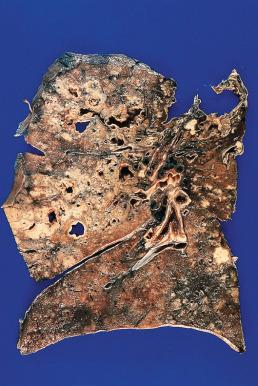
Tuberculous cavities removed in patients after prolonged antimicrobial therapy may show resolution into a stellate scar. In other patients the lesion stabilizes as a chronic open cavity that may harbor viable organisms in inspissated caseous material. Treated tuberculosis rarely resolves into a sterile cavity with a thin fibrous wall and a smooth surface that has no lining except for a short squamous segment at the point where the bronchus enters the cavity. Examination of these healed cavities for acid-fast organisms is invariably negative.
Tuberculomas , a term referring to localized conglomerates of necrotizing granulomatous infection due to Mycobacterium tuberculosis presenting as solitary lung nodules, are usually seen in adults and are a form of tuberculous reinfection. This is the form of tuberculosis most likely to be encountered by the surgical pathologist. Grossly, tuberculomas present as round, discrete, firm nodules ( Fig. 10.13 ); they are usually solitary and located immediately beneath a white or slightly yellowish pleura. On section the lesions show central necrosis that may be complicated by calcification or cavitation. Microscopically, there is often central caseous necrosis characterized by paucicellular, granular, eosinophilic debris surrounded by a mixed inflammatory infiltrate that includes epithelioid and multinucleated giant cells with associated fibrosis ( Fig. 10.14 ). Non-necrotizing granulomas are often present in the adjacent lung tissue. Specific pathogens cannot be reliably predicted on the basis of routine histologic finding in necrotizing granulomatous inflammation and frequently require special stains, cultures, or molecular studies for identification. Organisms are usually present within the central zone of necrosis and can be demonstrated using Ziehl–Neelsen or other comparable stains for acid-fast bacilli ( Fig. 10.15 ). Highly sensitive molecular genetic techniques are available in a limited number of centers and may be helpful in highly selected cases.
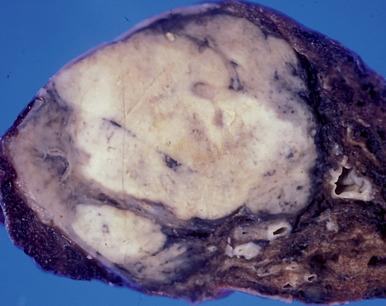
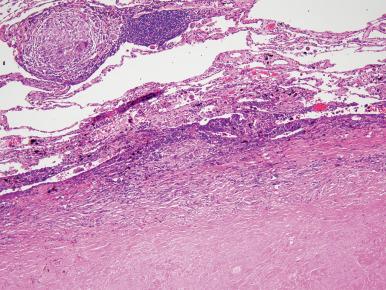
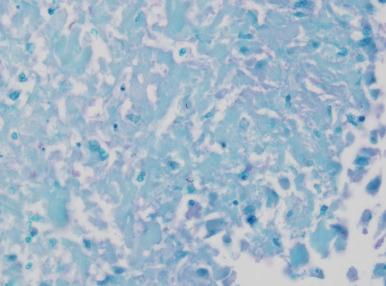
A significant number of granulomatous infections of the lung are caused by ‘atypical’ or ‘unclassified’ mycobacteria, such as M. avium complex (MAC), M. kansasii , M. xenopi, and M. abscessus . Many of these cases are seen in immunocompromised hosts and/or in patients with preexisting lung disease, including chronic obstructive lung disease, previous tuberculosis, pneumoconiosis, bronchiectasis, and lung carcinoma. Infection due to MAC in elderly women may resemble the middle lobe syndrome (Lady Windermere syndrome). Hot tub lung refers to a syndrome resembling hypersensitivity pneumonia resulting from exposure to hot tubs contaminated with nontuberculous mycobacteria.
Infections by atypical mycobacteria cannot be distinguished from tuberculosis on the basis of their gross or microscopic appearance ( Fig. 10.16 ). The diagnosis may be suspected from the appearance of the organisms in acid-fast preparations, since they tend to be longer (about 20 µm), thicker, more coarsely beaded, and much more bent than tubercle bacilli. However, positive identification of the organism by culture and/or polymerase chain reaction (PCR) techniques is necessary for precise speciation.
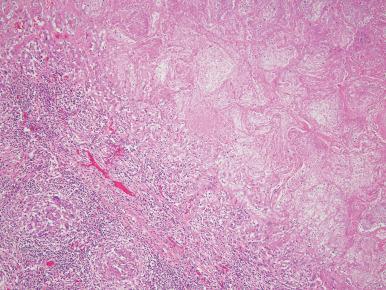
Granulomatous infections due to organisms other than tuberculous and nontuberculous mycobacteria likely to be encountered by surgical pathologists comprise mainly fungal infections that target immunocompetent as well as immunocompromised patients. Rates of disease for individual pathogens are linked to geographic variation in prevalence of the organisms. In North America those most likely to present as necrotizing granulomatous inflammation in surgical specimens include histoplasmosis, blastomycosis, cryptococcosis, and coccidioidomycosis. These same organisms have a worldwide distribution, causing disease in Central and South America, parts of Asia, Africa, and Europe.
Granulomatous fungal infections have highly variable clinical manifestations, often presenting as asymptomatic solitary pulmonary nodules ( Fig. 10.17 ). The inflammation in each of these conditions frequently includes a combination of necrotizing and non-necrotizing granulomas with overlapping histologic features making it difficult to predict a specific pathogen on the basis of the histologic findings alone. Diagnosis is dependent on identifying the organisms for which special stains (e.g. GMS) are extremely helpful ( Fig. 10.18 ). Blastomyces dermatitidis ( Fig. 10.19 ), Cryptococcus neoformans ( Figs. 10.20 and 10.21 ), and Coccidioides immitis ( Fig. 10.22 ) are visible on routinely stained sections in which their distinctive morphologic features are sometimes seen to better advantage. Histoplasma capsulatum is usually not visible on routinely stained sections except in disseminated histoplasmosis in which numerous organisms parasitize dense infiltrates of histiocytes without well-formed granulomas ( Fig. 10.23 ).
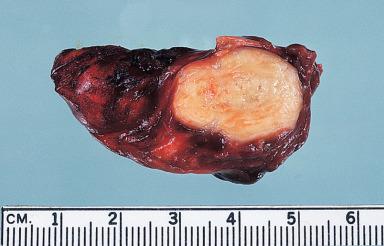
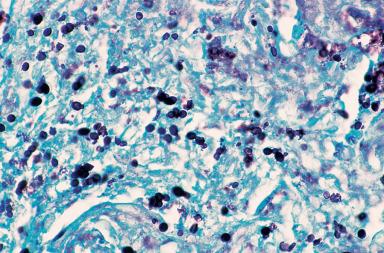
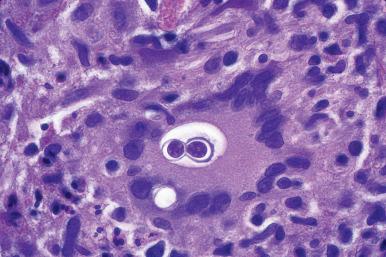
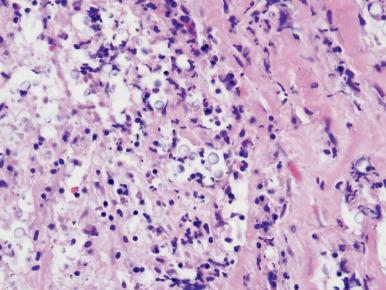
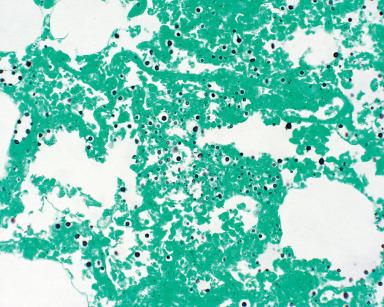
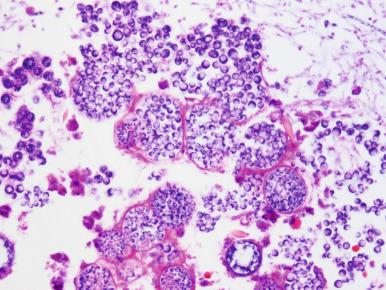
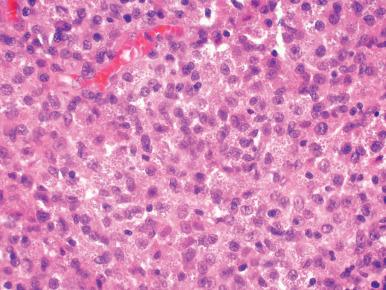
Dirofilariasis of the lung usually presents as an incidental asymptomatic solitary nodule on chest radiographs or CT scans performed for other reasons, but it can also be multiple and/or symptomatic ( Fig. 10.24 ). Microscopically, there is a histiocyte-rimmed necrotic nodule with marked eosinophilia containing fragments of Dirofilaria immitis ( Fig. 10.25 ).
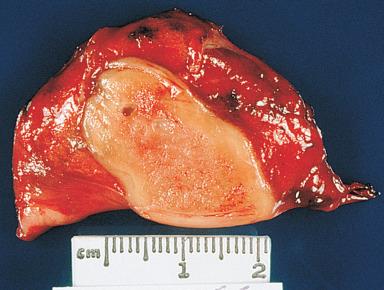
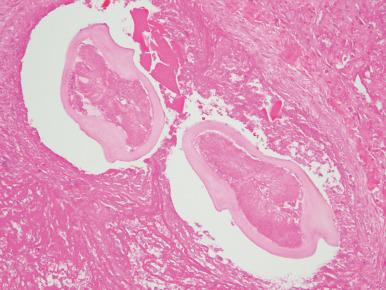
Sarcoidosis can present in the thoracic cavity in various ways: moderate to marked perihilar lymph node involvement without pulmonary disease, diffuse pulmonary disease without radiographic evidence of node involvement, a combination of lymph node enlargement and diffuse pulmonary disease, pulmonary interstitial fibrosis, and localized bronchostenosis with distal bronchiectasis and atelectasis. The great majority of cases fall into the first and third categories. The etiology of sarcoidosis remains controversial.
Microscopically, the hallmark of the disease is a compact noncaseating granuloma composed of epithelioid cells, Langhans giant cells, and lymphocytes ( Fig. 10.26 ). These compact, well-formed granulomas are confined to the interstitium, where they tend to be distributed along lymphatic pathways and may coalesce to form macroscopic nodules (nodular sarcoidosis) ( Fig. 10.27 ).
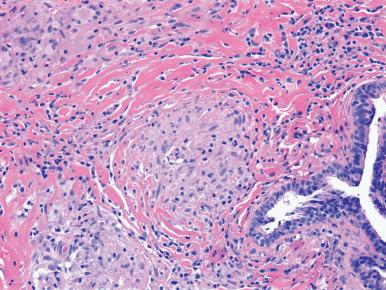
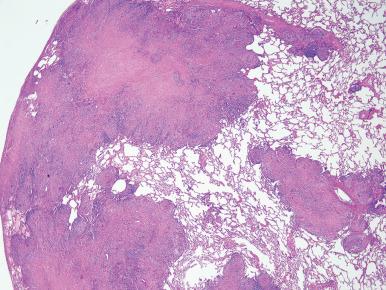
There are many variations in this morphologic theme. Circumferential fibrosis, central hyalinization, and diffuse interstitial fibrosis in late stage disease may render the diagnosis difficult. Small foci of necrosis having a bright eosinophilic (‘fibrinoid’) appearance may be found in the center of some granulomas. Intracellular and extracellular inclusions of several kinds may be seen, including birefringent calcium salts, but none is specific. The granulomas often surround bronchioles (but not large bronchi); because of this, transbronchial lung biopsy is positive in more than 80% of the cases. Granulomas are also frequently present around and within blood vessel walls including predominantly pulmonary veins, and may contribute to pulmonary hypertension. Vascular necrosis, however, is not a feature.
Necrotizing sarcoid granulomatosis is the name given by Liebow to a pulmonary disease characterized by extensive vascular granulomas that infiltrate and occlude pulmonary arteries and veins and are accompanied by widespread necrosis of lung tissue ( Fig. 10.28 ). The preponderance of evidence strongly suggests that this is a variant of nodular sarcoidosis. Response to steroid and immunosuppressive drugs is good, and excision of localized lesions is usually curative.
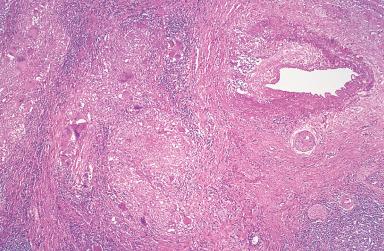
Granulomatosis with polyangiitis (Wegener's) , abbreviated GPA , is the term endorsed by a number of authoritative medical societies for the syndrome referred to historically as Wegener granulomatosis. GPA is the best known member of the group of heterogeneous diseases designated by Liebow as pulmonary angiitis and granulomatosis . It is increasingly clear that this group comprises a number of totally unrelated entities, and it is therefore a term of historical interest but one that should not be retained for current disease classification. It is perhaps more useful to categorize GPA with the other antineutrophil cytoplasmic autoantibody (ANCA)-associated small vessel vasculitides: microscopic polyangiitis and eosinophilic granulomatosis with polyangiitis (EGPA) (Churg–Strauss) , an asthma-associated vasculitis referred to historically as Churg–Strauss syndrome. ANCA characterized by a cytoplasmic (C-ANCA) staining pattern with immunofluorescence and/or corresponding antiproteinase three antibodies with the ELISA test are found in over 90% of classic cases of GPA and in about 60% of patients with limited disease and can be a useful adjunct in diagnostically challenging cases.
GPA is defined by a combination of necrotizing granulomatous inflammation and necrotizing vasculitis targeting small to medium size vessels. Classic GPA is characterized by the triad of necrotizing angiitis, aseptic necrosis (involving both the upper respiratory tract and the lungs), and focal glomerulitis. Other vessels may be involved, such as the temporal artery and cutaneous small vessels, resulting in tumefactive lesions at extrapulmonary sites. If untreated, the disease runs an accelerated clinical course; however, it has proved quite responsive to cytotoxic drugs (particularly cyclophosphamide) as first line induction therapy. Current treatment strategies for refractory disease and maintenance therapy include a growing list of novel agents such as rituximab which may selectively target vasculitis-associated changes while being relatively ineffective for granulomatous inflammation.
The lungs are commonly involved at the time of diagnosis in patients with GPA. The main morphologic change in the lungs is necrotizing granulomatous inflammation grossly resembling other localized necrotizing processes ( Fig. 10.29 ). The necrotic zones have an irregularly shaped (geographic) configuration at low magnification and are occasionally centered on airway lumens, a phenomenon that when dominant is referred to as the bronchocentric variant ( Figs. 10.30 and 10.31 ). The necrosis often has a characteristic ‘dirty’ basophilic appearance due to prominent karyorrhexis of neutrophils. Smaller granulomatous microabscesses with centrally necrotic zones containing nuclear dust surrounded by palisaded histiocytes and multinucleated giant cells are another distinctive form of granulomatous inflammation characteristic of GPA ( Fig. 10.32 ). Well-formed non-necrotizing granulomas like those seen more commonly in granulomatous infections and sarcoidosis are generally not present in GPA. In addition to neutrophils and modified histiocytes, the mixed inflammatory infiltrate invariably includes eosinophils, lymphocytes, and plasma cells in various proportions. Eosinophils are common and when conspicuous account for descriptions of the eosinophilic variant . Establishing the diagnosis with confidence requires a destructive leukocytolytic angiitis involving arteries and veins ( Fig. 10.33 ). The vasculitis is patchy in distribution characterized by abrupt transmural neutrophil-rich inflammatory infiltrates with associated karyorrhexis and vessel wall necrosis. Occasionally the necrotizing vasculitis includes granulomatous features in the form of multinucleated giant cells. In rare cases diffuse pulmonary hemorrhage with associated necrotizing capillaritis is a dominant feature, a combination of findings also seen in other vasculitic syndromes, including microscopic polyangiitis and systemic lupus erythematosus ( Fig. 10.34 ). The diagnosis of GPA can be made or suggested in transbronchial biopsy specimens.
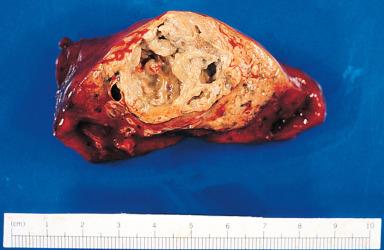
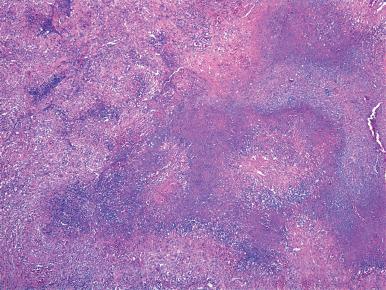
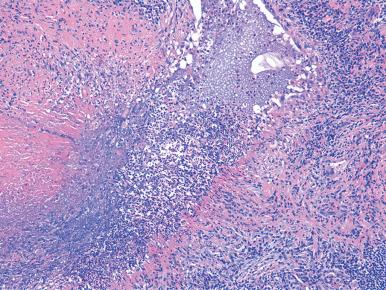
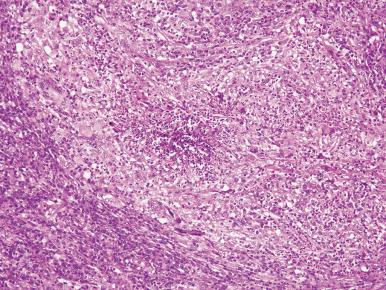
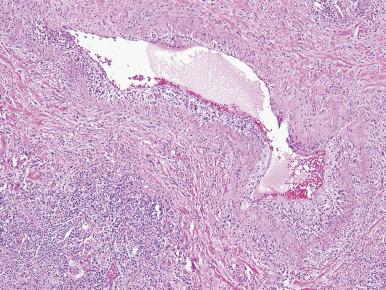
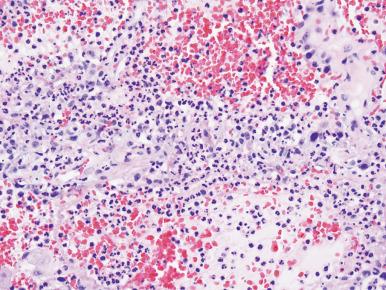
Limited (localized) GPA is confined to the lungs, more specifically with no renal involvement, and has a more protracted clinical course. Steroids and cytotoxic drugs are highly effective. Grossly, there are multiple bilateral nodules, some round and others infarctlike, frequently located in the lower lobes. Microscopically, the disease is indistinguishable from the classic variety. Necrotizing vasculitis is a requisite for the diagnosis. However, it should be recognized that vessels located within ordinary infectious granulomas can exhibit secondary inflammatory changes that mimic vasculitis. Therefore the presence of angiitis away from the areas of necrosis and massive inflammation should be searched for to document the diagnosis. The diagnosis of GPA should be made with caution in granulomas that appear solitary by radiographic examination.
EGPA (Churg–Strauss) is the current term for the disease referred to historically as Churg–Strauss syndrome. EGPA is defined by a combination of necrotizing granulomatous inflammation, eosinophilia, and necrotizing vasculitis involving small and medium-size vessels. It presents a clinical picture of systemic vasculitis resembling polyarteritis nodosa but is associated with asthma, peripheral eosinophilia (up to 80%), and a higher incidence of pulmonary involvement. In some patients this asthma-associated vasculitis syndrome may be unmasked or exacerbated when transitioning from corticosteroids to steroid-sparing leukotriene receptor antagonists, such as montelukast, although the precise role that these agents have in the pathogenesis of vasculitis remains controversial.
Microscopically, both the pulmonary and the extrapulmonary lesions are characterized by a prominent eosinophilic infiltrate, foci of necrosis (some associated with eosinophils and some unrelated to them), a granulomatous reaction around some of these necrotic foci, and necrotizing vasculitis. Finding all of these features in a single biopsy is uncommon, and therefore establishing the diagnosis on the basis of lung biopsy often requires careful correlation with other clinical and laboratory data. In lung biopsies, for example, the eosinophilic infiltrates often take the form of eosinophilic pneumonia, which is a relatively nonspecific finding in the absence of necrotizing granulomatous inflammation and/or necrotizing vasculitis. About 70% of patients will have a positive P-ANCA corresponding to an anti-myeloperoxidase (MPO) autoantibody by ELISA.
Bronchocentric granulomatosis is a form of necrotizing granulomatous inflammation in which all or nearly all the granulomas are centered on bronchi and bronchioles, leading to their destruction. Broncho- or bronchiolocentric necrotizing granulomatous inflammation is not specific to any one disease and can be seen in GPA as well as granulomatous infections. For that reason the term bronchocentric granulomatosis is generally limited to patients with allergic bronchopulmonary aspergillosis , a disease occurring almost exclusively in asthmatics and patients with cystic fibrosis in whom the bronchocentric granulomatosis ( Fig. 10.35 ) is usually accompanied by eosinophilic pneumonia and mucoid impaction of bronchi. Globally allergic bronchopulmonary mycosis can be due to other fungi, such as Candida albicans , Bipolaris , and Curvularia organisms.
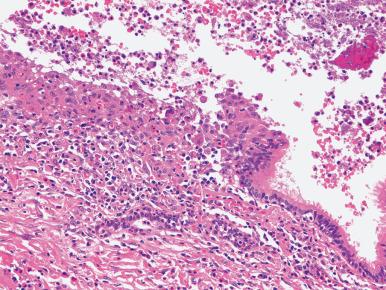
Mucoid impaction of bronchi is a process in which proximal ectatic bronchi become filled with thick inspissated mucus ( Fig. 10.36 ). This change may cause localized radiological abnormalities for which diagnostic considerations include neoplasms. Occasionally patients expectorate these histologically distinctive plugs that comprise a combination of inspissated mucus, necrotic eosinophils, and Charcot–Leyden crystals distributed in a layered fashion resembling the rings of a tree ( Fig. 10.37 ).
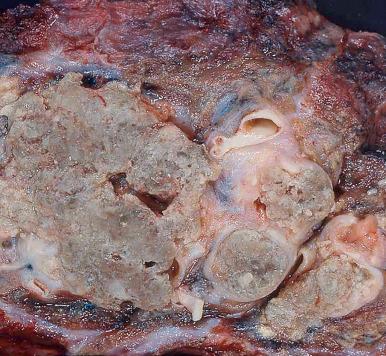
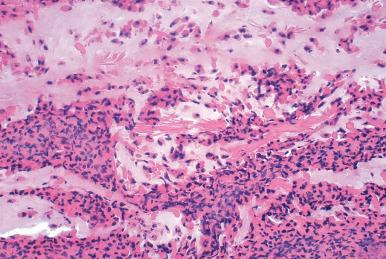
Granulomas are occasionally seen in other noninfectious conditions, including aspiration of particulates and drug abuse in which inorganic fillers common in the oral medications used instead for intravenous injection elicit a perivascular granulomatous response ( Fig. 10.38 ). Occasionally granulomas are present in diffuse lung diseases other than sarcoidosis, including most commonly hypersensitivity pneumonia, lymphoid interstitial pneumonia, and related forms of lymphoid hyperplasia, and eosinophilic pneumonia.
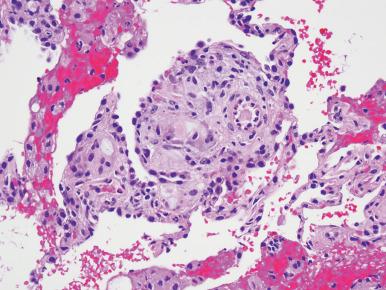
This is a complex group of non-neoplastic pulmonary diseases that often require correlation of morphologic, clinical, and radiological findings. High-resolution computed tomography (HRCT) represents a major advance in this area, and a multidisciplinary approach provides at present the highest levels of diagnostic reproducibility.
Idiopathic interstitial pneumonias account for a substantial subset of the diffuse lung diseases that a surgical pathologist is likely to encounter and can be divided into chronic fibrosing interstitial pneumonias, smoking-related interstitial pneumonias, and the acute or subacute interstitial pneumonias ( Table 10.1 ). The chronic fibrosing interstitial pneumonias comprise the largest category and account for over 80% of patients with idiopathic interstitial pneumonia who undergo surgical lung biopsy. The same range of histologic abnormalities also occur in patients with underlying connective tissue diseases, a distinction that hinges in large part on clinical and laboratory studies.
| Chronic fibrosing interstitial pneumonias | UIP |
| NSIP | |
| Smoking-related interstitial pneumonias | RBILD |
| SRIF | |
| Acute/subacute interstitial pneumonias | Diffuse alveolar damage |
| Organizing pneumonia | |
| Rare interstitial pneumonias | LIP |
| Pleuroparenchymal fibroelastosis | |
| Unclassifiable interstitial pneumonia |
Usual interstitial pneumonia (UIP) is the most common of the idiopathic interstitial pneumonias, accounting for nearly two-thirds of patients who undergo biopsy for diffuse lung disease of unknown cause. Most patients with UIP fall into the clinical category of idiopathic pulmonary fibrosis (IPF), a syndrome that classically has an insidious onset characterized by a combination of breathlessness and cough with a relentlessly progressive evolution, many of the patients dying of respiratory failure after 3–4 years. Acute exacerbation is increasingly recognized as a common final pathway in patients with underlying UIP and is characterized by sudden worsening of symptoms and more rapid progression of respiratory failure. Some instances of UIP show a familial pattern indicating a heritable predisposition. Others have underlying systemic connective tissue diseases, most commonly rheumatoid arthritis, scleroderma, and systemic lupus erythematosus.
Microscopically, UIP is a primarily interstitial fibrosing process. According to Katzenstein et al., the single most important feature that distinguishes UIP from the other interstitial pneumonias (including so-called NSIP) is the marked regional variation in the nature and degree of the fibrosis, with a distinct patchwork distribution and evidence of architectural derangement ( Fig. 10.39 ). The architectural derangement takes the form of scarring and honeycomb change , the latter referring to cystic spaces situated within distally collapsed, fibrotic lung ( Fig. 10.40 ). Areas of fibrosis in UIP are often most advanced in peripheral, subpleural lung where it is frequently associated with smooth muscle hyperplasia. Small fibroblast foci are often sandwiched between surface epithelium and fibrotic scar and are composed of spindled fibroblasts and myofibroblasts organized in a vaguely linear fashion within a pale-staining stroma ( Fig. 10.41 ). These findings are complicated by a superimposed pattern of acute lung injury that usually takes the form of organizing DAD in patients with acute exacerbation. Less commonly patients with acute exacerbation show a combination of UIP and organizing pneumonia. Patchy changes resembling eosinophilic pneumonia have also been described in UIP and appear to have limited clinical significance.
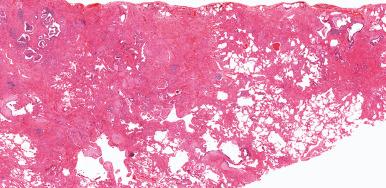
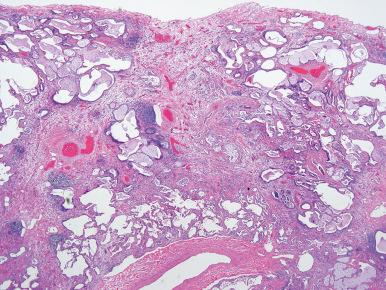
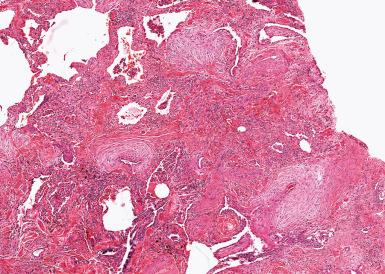
Ultrastructural studies suggest that fibroblast foci are foci of abnormal wound healing in which activated mesenchymal cells migrate from the interstitial into the intraluminal compartment through defects in the basement membrane following epithelial necrosis, resolving through a disordered process of alveolar collapse, reepithelialization, and remodeling. Fibroblast foci are characteristic of UIP but are not specific and can be seen in other diffuse lung diseases. They are the consequence of aberrant activation of epithelial cells and fibroblasts in lungs with an aging phenotype leading to accumulation of extracellular matrix and architectural distortion.
NSIP/fibrosis is a term that was originally used for cases that could not be classified into any of the major categories of interstitial pneumonia, but which has now acquired an identity of its own. Patients with NSIP fall into several different categories, including a subset with underlying systemic connective tissue disorders in which NSIP is the most common form of diffuse fibrotic lung disease. NSIP is the second most common finding in patients with interstitial pneumonias of unknown cause (‘idiopathic NSIP’). In either circumstance patients with NSIP generally have a better prognosis than patients with UIP.
The main morphologic difference with UIP is that NSIP lacks the heterogeneous pattern of lung involvement characteristic of the former ( Fig. 10.42 ). The changes in NSIP may be patchy or diffuse but retain a degree of qualitative uniformity in areas of abnormality that set it apart from UIP. Interstitial structure including alveolar septa are expanded by an inflammatory infiltrate with (‘fibrotic NSIP’) or without (‘cellular NSIP’) collagen fibrosis ( Fig. 10.43 ). Even with fibrosis, NSIP lacks the architectural derangement typical of UIP and instead is characterized by relative preservation of lung structure. Focal areas resembling NSIP can occur in otherwise classical UIP, which is why deciding that NSIP is a representative finding even in surgical lung biopsies requires careful correlation with clinical and radiological information.
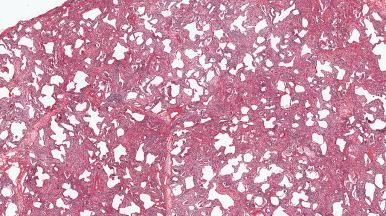
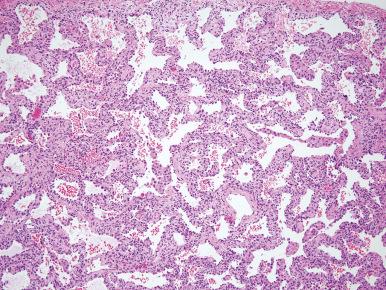
Respiratory bronchiolitis is a common incidental finding in heavy smokers but in some instances accounts for a form of symptomatic diffuse lung disease referred to as respiratory bronchiolitis-interstitial lung disease (RBILD). Histologically, respiratory bronchiolitis is characterized by an accumulation of lightly pigmented alveolar macrophages within respiratory bronchioles spilling into neighboring alveoli ( Fig. 10.44 ). The changes differ from the lesion referred to historically as desquamative interstitial pneumonia (DIP) in that the histiocytic accumulation is centriacinar instead of diffuse and lacks an associated interstitial pneumonia. Occasionally, RBILD is accompanied by mild, paucicellular fibrosis in the form of lamellar eosinophilic collagenous thickening of alveolar septa in a patchy, mainly subpleural distribution, a condition referred to as smoking-related interstitial fibrosis (SRIF) ( Fig. 10.45 ) that is not to be confused with chronic fibrosing interstitial pneumonias such as UIP and NSIP. The presence or absence of SRIF is not helpful in distinguishing patients with incidental respiratory bronchiolitis from those with RBILD, a distinction that is primarily dependent on clinical and radiological data. It is likely that SRIF in patients with symptomatic lung disease not attributable to COPD includes what would have been referred to historically as DIP.
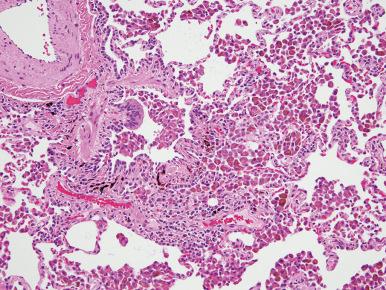
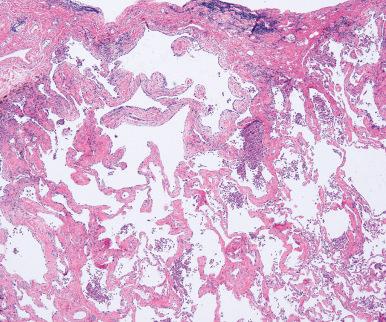
DIP was defined historically by a filling of the alveolar spaces by large mononuclear cells, associated with relatively minor interstitial changes ( Fig. 10.46 ). Ultrastructurally, the cells that were originally thought to be desquamated pneumocytes have features of macrophages instead, making the term DIP a misnomer. Katzenstein and others have proposed that patients previously diagnosed as DIP are more properly categorized today as RBILD, SRIF, or NSIP, and therefore the term DIP should be abandoned (personal communication). Others have argued for continued use of the term, citing potentially important prognostic differences. Whatever terminology one prefers for this uncommon group of overlapping conditions the important point is to avoid confusing them with UIP given that all of them have a better prognosis and frequently benefit from some combination of smoking cessation and steroids.
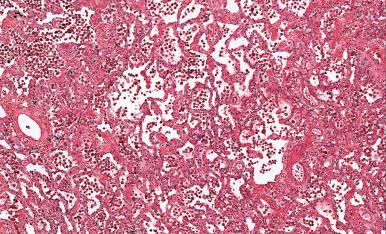
DAD is usually diffuse and bilateral in patients with the acute respiratory distress syndrome (ARDS). It may be caused by infectious agents (particularly viruses), inhalants (such as oxygen), drugs (especially chemotherapeutic agents), ingestants (such as kerosene or paraquat), shock, sepsis, radiation, and acute exacerbation of UIP. With the exception of pathogens detectable on routine histology or with special stains, the cause of DAD cannot be determined from the microscopic picture alone. The earliest stages consist of edema, intra-alveolar hemorrhage, and fibrin deposition. This is followed by hyaline membrane formation (most prominent 3–7 days after the injury), a sparse interstitial inflammatory infiltrate, fibrin thrombi (inconstant), and hyperplasia of the alveolar lining cells ( Fig. 10.47 ). These cells, which are mainly reparative type II (granular) pneumocytes, may exhibit atypia, mitotic activity, and cytoplasmic hyaline bodies. A distinctive form of squamous metaplasia in bronchiolar epithelium combined with cytologic atypia can be pronounced enough to mimic a squamous cell carcinoma. Foamy alveolar macrophages may also be present and may be more common in cases resulting from amiodarone. In a later (organizing) stage, there is interstitial and intraluminal proliferation of organizing fibroblasts and myofibroblasts associated with persistence of the hyperplastic lining cells and collapse of alveolar structures resulting in marked architectural remodeling ( Fig. 10.48 ).
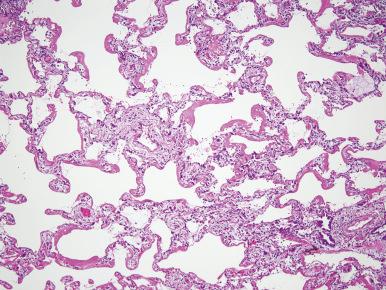
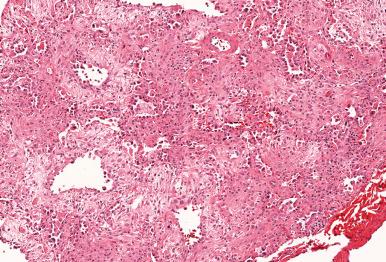
Acute interstitial pneumonia (AIP) is a rapidly progressive form of idiopathic interstitial pneumonia and is synonymous with the Hamman–Rich syndrome . By definition, there is no identifiable initiating event. The typical patient is a young adult who presents with dyspnea following an influenza-like illness. The prognosis is very poor, with most patients dying within 2 months of onset. Microscopically, the appearance is equivalent to that of the organizing phase of DAD, the most striking feature being the interstitial expansion and distortion by organizing fibroblasts and myofibroblasts.
Organizing pneumonia , also termed bronchiolitis obliterans–organizing pneumonia (BOOP), is a nonspecific form of organizing acute or subacute lung injury that is associated with several conditions, including infections, inhalants (including silo-filler's lung), drugs, and collagen-vascular diseases. Organizing pneumonia occasionally occurs as a form of diffuse lung disease of unknown (‘idiopathic’) cause termed cryptogenic organizing pneumonia (COP), a syndrome referred to historically as idiopathic BOOP. COP is frequently grouped with the idiopathic interstitial pneumonias, but the clinical and radiological findings at presentation more closely mimic the features of infectious pneumonia. The onset is usually acute and characterized by cough, dyspnea, fever, and malaise. Less commonly COP presents as a solitary radiological opacity that may be asymptomatic and mimic the appearance of a neoplasm, a variant to which some have applied the term focal organizing pneumonia ( Fig. 10.49 ). The prognosis is generally excellent; patients requiring treatment often improve with sustained corticosteroids but may relapse when their steroid dose is tapered. Morphologically, the hallmark of organizing pneumonia in any clinical context is represented by fibroblastic plugs (‘Masson bodies’) filling air spaces ( Fig. 10.50 ). These plugs have a typical elongated to serpiginous, bifurcating shape reflecting the configuration of distal bronchioles and alveolar ducts and are formed by spindle to stellate fibroblasts embedded in a pale-staining matrix. Other changes include clusters of foamy macrophages, a few scattered neutrophils, and thickening of alveolar septa in the areas of intraluminal fibrosis. It is characteristic for the process to have a patchy appearance on low-power examination, a feature of importance in the differential diagnosis with UIP (see earlier). The rare cases of COP with unfavorable outcome (steroid unresponsive) have shown scarring and remodeling of the lung parenchyma on microscopic examination, suggesting an underlying chronic fibrosing lung disease.
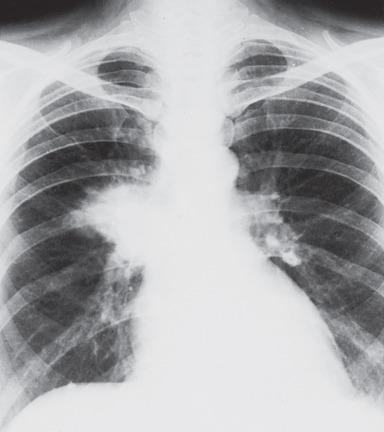
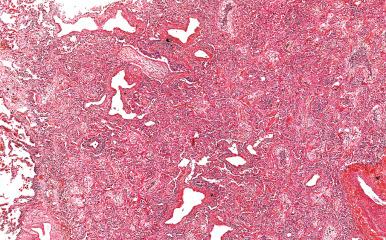
Lymphoid (lymphocytic) interstitial pneumonia (LIP) is characterized by a lymphocytic infiltrate with associated lymphoid follicles, often admixed with histiocytes and plasma cells, that expands alveolar septa and peribronchiolar interstitium. Although included by some as a rare form of idiopathic interstitial pneumonia, LIP is a lymphoproliferative disorder analogous to reactive lymphoid hyperplasia that overlaps clinically, radiologically, and histologically with follicular bronchiolitis. A third of the cases have been associated with Sjögren syndrome, a circumstance in which distinction from marginal zone lymphoma of mucosa-associated lymphoid tissue (MALT) may be challenging. Another large subset of cases are associated with underlying immunodeficiencies, including HIV infection and common variable immunodeficiency. Some of the cases have been incorporated into the ever-enlarging spectrum of IgG4 disease. The radiological appearance is that of interlobular septal lines often accompanied by ground-glass opacities and cysts. Cysts occur especially in patients with underlying Sjögren's syndrome, including some with diffuse variants of MALT lymphoma, often with associated amyloid or non-amyloid light chain deposition. Histologically alveolar septa are expanded by a cellular infiltrate composed of a combination of lymphocytes and plasma cells with prominent peribronchiolar lymphoid follicles, many of them with secondary germinal centers ( Fig. 10.51 ). Non-necrotizing granulomas accompany the infiltrates in some cases. Granulomas are especially common in patients with common variable immunodeficiency for which the term granulomatous and lymphocytic interstitial lung disease is sometimes used.
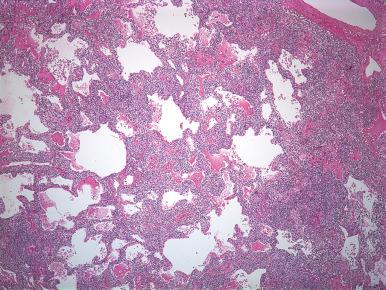
LIP overlaps with follicular bronchitis and bronchiolitis , a nonspecific inflammatory reaction in which reactive germinal centers are seen adjacent to airways in the absence of chronic obstructive pulmonary disease. Follicular bronchitis/bronchiolitis is a common secondary finding in bronchiectasis but also occurs as a primary lymphoproliferative disorder in the same clinical circumstances described for LIP.
Pleuroparenchymal fibroelastosis (PPFE) is a rare pattern of diffuse lung fibrosis with histologic features that overlap with the much more common apical cap , a localized form of fibroelastosis unique to the lung apices and superior segments of the lower lobes. PPFE tends to preferentially affect the upper lobes and is exquisitely localized to peripheral subpleural parenchyma and bronchovascular bundles ( Fig. 10.52 ). PPFE is not a specific disease in that this pattern of fibrosis occurs in a number of clinical scenarios, including lung and stem cell transplants, drug-induced lung disease, and connective tissue disease. Importantly this form of peripheral fibroelastosis can also coexist with other forms of diffuse fibrotic lung disease, most importantly UIP.
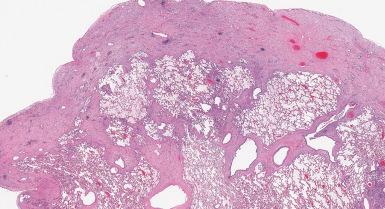
Hypersensitivity pneumonia (extrinsic allergic alveolitis) is the generic term given to an acute, subacute, or chronic inflammatory process representing a tissue reaction to an inhaled allergen. Patients suffering from this condition have both cellular and humoral immune processes directed against the organic allergen. The most common offending antigens include thermophilic bacteria (e.g. farmer's lung, humidifier lung), molds (e.g. Japanese summer type hypersensitivity), and avian proteins (e.g. pigeon breeder's lung). In acute hypersensitivity pneumonia, fever and dyspnea develop a few hours after exposure to relatively high doses of the offending antigen. With repeated exposures, often to relatively low doses of an environmental antigen that may be unknown to the patient, a chronic fibrosing lung disease develops than can mimic many of the features of IPF.
Microscopically, classical hypersensitivity pneumonia is characterized by a combination of a cellular interstitial pneumonia that tends to be accentuated around airways (bronchiolocentric) , equally cellular chronic bronchiolitis, and a distinctive pattern of granulomatous inflammation ( Figs. 10.53 and 10.54 ). This combination of findings predicts for the diagnosis of hypersensitivity pneumonia even in patients for whom no exposure was known prior to lung biopsy. Fibrosis occurs in some patients and when advanced can closely mimic UIP or the fibrotic stage of NSIP; the presence of isolated giant cells, poorly formed granulomas, and/or Schaumann bodies in a peribronchiolar location should suggest the right diagnosis. Fibrosis is associated with a generally poor prognosis.
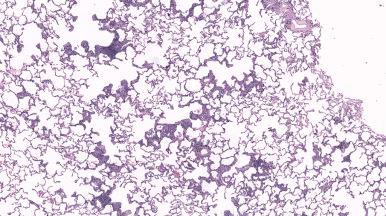
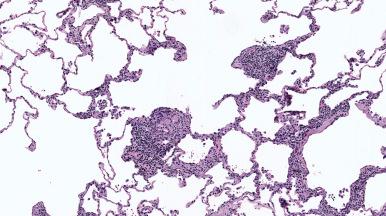
Silo-filler's disease should be clearly separated from the aforementioned group, since it is a form of acute lung injury secondary to nitrogen dioxide inhalation and is characterized by the presence of DAD without granulomatous inflammation.
Pulmonary LCH , referred to historically as Langerhans cell granulomatosis, histiocytosis X, and eosinophilic granuloma of the lung, is most commonly seen in the third and fourth decades of life. LCH occurs almost exclusively in cigarette smokers in whom it typically presents as a diffuse process and rarely as a solitary nodule. It predominates in the upper lobes and produces a combination of nodules and cavitary lesions or cysts. In approximately 20% of the patients, there is associated extrapulmonary involvement, usually as isolated lesions in bones or the pituitary region. Spontaneous pneumothorax is a common complication. In most patients with LCH of the lung, the disease resolves or stabilizes. A few patients develop progressive pulmonary disease that is ultimately fatal.
Microscopically, there is a compact interstitial infiltrate that expands peribronchiolar interstitium and is, composed of Langerhans cells, variable numbers of eosinophils, and other mononuclear inflammatory cells ( Fig. 10.55 ). Langerhans cells are the essential element for the diagnosis; they have an abundant acidophilic cytoplasm and a vesicular nucleus, with typical grooves and indentations (caveat: similar grooves also can be seen in reactive mesothelial cells and alveolar macrophages) ( Fig. 10.56 ). Immunohistochemical staining for S-100 protein, CD1a, or langerin can be very helpful in highlighting Langerhans cells and can also be applied to cells in bronchoalveolar lavage fluid. The bronchiolocentric nodules heal through a process of fibrosis that begins in the center eventually extending into peribronchiolar alveolar septa where it is accompanied by a characteristic patter of scar emphysema (paracicatricial air space enlargement). At this late fibrotic stage it may be very difficult to establish a microscopic diagnosis of LCH since the characteristic Langerhans cells may be absent ( Fig. 10.57 ). Correlation with CT scans can be helpful in showing a pattern and distribution of cystic lung disease characteristic of LCH. In the healing stage, the disease may no longer be diagnosable microscopically.
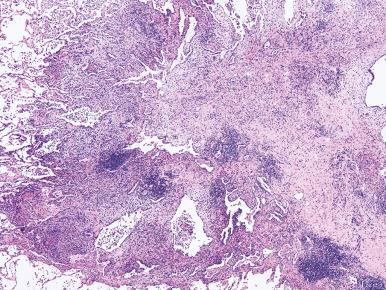
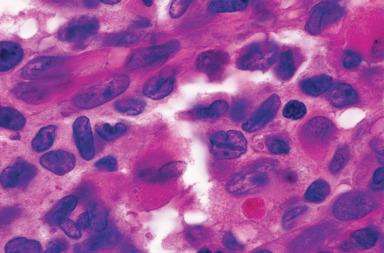
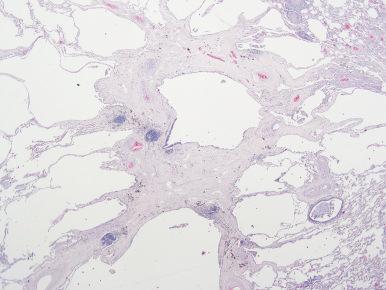
Molecular studies using a variety of techniques suggest that there is a clonal proliferation of Langerhans cells in at least a subset of patients. Evidence of clonal evolution in pulmonary LCH includes BRAF V600E mutations in 20%–50% of patients. Some of these patients may benefit from targeted therapy with vemurafenib.
Reactive eosinophilic pleuritis is a nonspecific response to pleural injury that may closely simulate LCH because of the mixture of eosinophils, mesothelial cells, and histiocytes (which can look very similar to Langerhans cells); in contrast to true eosinophilic granuloma, this lesion by itself does not show interstitial lung disease. However, in some instances it may be accompanied by eosinophilic infiltration of the pulmonary vessels.
Erdheim–Chester disease is another histiocytic disorder which can affect the lung, in conjunction with bones (the latter often in the form of symmetric osteosclerosis), soft tissues, and the central nervous system. Pulmonary involvement is typically septal (lymphatic) in distribution and characterized by an infiltrate of foamy histiocytes, lymphocytes, and Touton giant cells ( Figs. 10.58 and 10.59 ). The histiocytes are consistently positive for CD68, sometimes reactive for S-100 protein, and negative for CD1a. Recent studies demonstrate BRAF V600E mutations in more than half as well as recurrent mutations in RAS and PIK3CA, indicating that this is a myeloid neoplasm for which targeted therapy with vemurafenib is proving effective in a large number of patients.
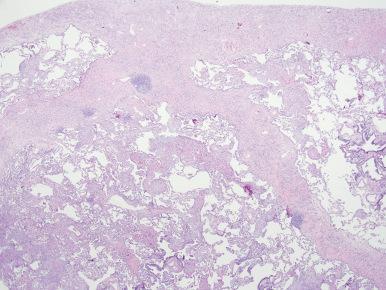
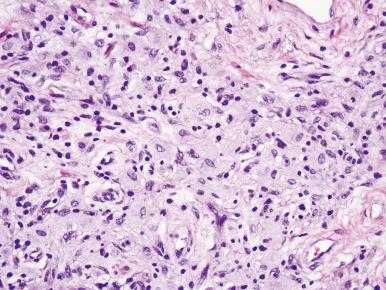
Rosai–Dorfman disease (sinus histiocytosis with massive lymphadenopathy) is seen in the lung parenchyma only exceptionally, in contrast to its relatively frequent involvement of the upper respiratory tract. The histologic findings overlap with IgG4-related disease, which is a diagnostic pitfall requiring careful correlation with the clinical and radiological findings.
Become a Clinical Tree membership for Full access and enjoy Unlimited articles
If you are a member. Log in here